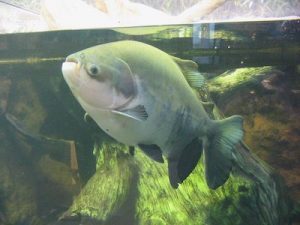Pacu Invasive Species
Reports from Papua New Guinea claim that the Pacu can grow very large and has turned into a man eater.
While the pacu (Piaractus brachypomus) is a vegetarian in it’s natural distribution, reports from Papua New Guinea claim that the Pacu can grow very large and has turned into man eater. In a recent episode of the Animal Planet’s, ‘River Monsters’, these claims were investigated as ‘something’ was attacking people and animals.
Several stories backed up the claims that these fish do attack humans with a very crushing and painful bite. Jeremy Wade caught a Pacu close to two feet in length, which is large enough to cause a painful bite and tear away a good chuck of flesh. While not a man eater, the fish deserve respect and should be handled with care if caught.
To date, there have not been any reports of the Pacu attacking humans in the United States. So far, most US waterways are considered safe for human recreation.
Pacu Distribution
The Pacu is a large and dangerous freshwater fish from South America. It is a vegetarian with powerful jaws and teeth designed to crack nuts. So far, nothing much to worry about, right? Wrong, more on this later.
The Pacu was introduced to many countries for a variety of reasons.
In the 1990s, the pacu was introduced to provide an alternative food source for the local people of many countries. Due to its size, and ability to adapt to hot climates, it was felt that it would make a perfect addition in areas where food is expensive and income scarce.
It has also been introduced to the United States, where it can be found in: Alabama, Arizona, Arkansas, California, Colorado, Georgia, Idaho, Indiana, Illinois, Kentucky, Maine, Maryland, Massachusetts, Michigan, Minnesota, Missouri, Nebraska, New Hampshire, New York, North Carolina, North Dakota, Ohio, Oklahoma, Pennsylvania, South Carolina, Texas, Utah, Wisconsin, and Wyoming.
Invasion or Introduction
The Pacu was introduced to Papua New Guinea as part of a government program to introduce a new species to the environment that would be able to provide food for the local population that lived along the bank of the Sepik River. The introduction was made in 1996 and since then the population of Pacu has striped away much of the original plant life, leaving little for the native population. It’s this lack of vegetation that is believed to have turned this vegetarian into a flesh eater.
Man Eater
Adding to the legend, the Pacu grows much larger in Papua New Guinea than it ever has in South America.
Several stories backed up the claims that these fish do attack humans with a very crushing and painful bite, in many cases biting at a man’s private parts and known by locals as the “ball biter”.
A pacu was caught close to two feet in length. Large enough to cause painful bites and tear flesh. While there are no official claims of the Pacu being a man eater, beware in waters where they are known to congregate.
Essentially, they are feeding every time they breathe and this allows them to grow very quickly while removing everything from the water. This leaves nothing for the native species like Buffalo.
Food Preference
The Pacu is a vegetarian in its natural habitat. However, the Pacu has no problem consuming food of any kind if its primary food source is depleted.
Because of their crushing jaws, they are not recommended as pets. Especially if young children are around.
Pacu in the News
A recent news article from Scotland told how a young girl had her finger injured requiring surgery after an incident at a local aquarium. ‘We believe the Pacu is not a vegetarian and that even in its natural habitat it feeds on other food sources besides seeds and nuts.’
In Forthworth, Texas, the owner of a Pacu had his nose bitten by his fish. It had jumped out of the tank, grabbing onto his owners nose with its teeth. The owner had surgery to reattach his nose.
 Releasing Pacu to the Wild
Releasing Pacu to the Wild
Most people that buy a Pacu for a home aquarium do not realize that they will keep growing regardless of the tank size. Keeping a Pacu in a tank can be very costly as they can grow to two feet or more. For many, it is easier to release them into the wild.
In cold climates like Canada, the northern United States and Great Britain, they die off in the winter as they are a tropical fish.
For the southern United States and other countries, they are able to gain a foothold and thrive in their new environment, out-eating native species and attacking people that swim in the water.


